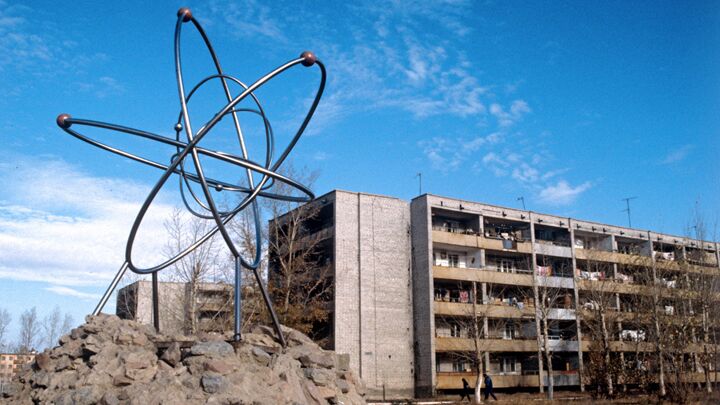
Did Terrorists Get Nuke Material From Semipalatinsk Test Site?
Just how bad could things get for our volatile world in the nuclear age?
Following the Boston bombing, Marc Thiessen, a political commentator and former speechwriter for President George W. Bush and Defense Secretary Donald Rumsfeld, wondered why al Qaeda hadn’t carried out more attacks like the one the Tsarnaev brothers pulled off. He wrote on April 22: “Why does [al Qaeda] remain so intently focused on spectacular, mass-casualty attacks, instead of smaller scale attacks like Boston—attacks that are much easier to pull off, and much harder for us to detect and prevent? Smaller scale attacks could be equally effective in paralyzing the country.”
George Moore, a nuclear scientist and former senior International Atomic Energy Agency (iaea) analyst from 2007 to 2012, analyzed the Boston bombing from a slightly different angle. He wondered, “What if the explosive devices allegedly used by the Tsarnaev brothers had contained radioactive material?” He then went on: “Many experts believe it’s only a matter of time before a dirty bomb or another type of radioactive dispersal device is used, with some expressing surprise that it hasn’t happened already. … It’s not pleasant to think through worst-case scenarios, but in this case it’s essential.”
A recent report about former Soviet nuclear test site Semipalatinsk in Kazakhstan reveals a worst-case scenario worth pondering.
Titled “Plutonium Mountain,” the report was released on August 15 by the Belfer Center for Science and International Affairs at Harvard. It revealed a 17-year, $150 million mission by Russian, Kazakh and American scientists to rid the site of residual radioactive material. The operation was completed in 2012, and a monument celebrating those efforts was erected, bearing the inscription: “1996-2012. The world has become safer.”
But how much safer is the world now? The reality indicates otherwise.
To begin with, “the operation was based almost entirely on ad hoc agreements struck at a lower level [by the scientists], and was carried to a conclusion without elaborate, negotiated state-to-state agreements of the kind used for arms control during the Cold War,” explains the report.
The scientists found “high purity” plutonium and uranium, enough to assemble a dozen nuclear bombs. Some of this material was removed, but some remained in underground tunnels, which the cleanup experts have since simply poured reinforced concrete over. Evidently, in spite of the inscription on the monument at Semipalatinsk, there are concerns that residual nuclear material on the site could have been, and still can be, stolen. When scientist Siegfried Hecker visited the site in 1998—two years after the project began—he reported that “access is unimpaired; no gates are manned … we have a strong concern that a proliferation risk may exist—material in reasonably concentrated form, easily picked up, completely open to whomever wants to come.”
Metal scavengers had dug up underground copper cables linked to the buried site. They easily could have accessed the radioactive material from the site.
The New York Times reported in 2011 that the U.S. State Department has drones keeping an eye on the nuclear site.
Until recently, the entire project had been kept secret, even from the iaea, to ensure it wasn’t made public.
Every year, the iaea receives hundreds of reports of thefts and unauthorized activities involving radioactive materials. At a conference in July on enhancing global nuclear security efforts, the director general of the iaea, Yukiya Amano, warned of the possibility of terrorist attacks involving radioactive material, saying that “the threat of nuclear terrorism is real.”
So, what if al Qaeda—which made headlines recently for threats that led to a number of U.S. embassies being shut down—resorts to relatively “small scale” attacks like the Boston bombing? What if those “small scale” attacks involved nuclear material, crude or refined? Surely, this would not be impossible.
In a November 2001 Trumpet article titled “The Future of Terror,” editor in chief Gerald Flurry wrote:
Perhaps a terrorist might hijack and explode a plane carrying nuclear waste as it is being transported, or crash an airplane into a nuclear power plant, or destroy industrial facilities which disassemble nuclear bombs. Carrying out any of these monstrous plots would pollute the environment with radiation and bring death on the wings of the wind.
So many opportunities remain open for terrorists, it is impossible to guard against all attacks. And God has prophesied that evil men will grow worse and worse (2 Timothy 3:13). That prophecy, written more than 1,900 years ago, is becoming increasingly relevant in our modern day. … Dark clouds of nuclear terrorism are on the horizon. Because mankind is trying to solve the problem on his own, we will surely have to weather some terribly stormy and blood-drenched times ahead.
The threat of nuclear terrorism is real, and only God can save us if we believe and obey Him. Mr. Flurry continued:
But at the end of it all, after Jesus Christ returns to put a stop to the madness of man and establishes God’s government of peace on Earth, mankind will be able to recognize the lesson in the horror movie we are experiencing today. How desperately this world needs God’s education and His righteous rulership, that we may put away the horror and learn to live up to our exalted, God-given potential.
For more about the reality of our nuclear world and the great hope beyond it, read We Have Had Our Last Chance and The Incredible Human Potential.
